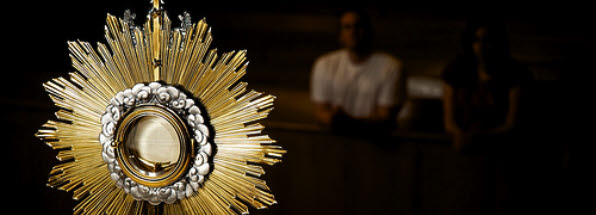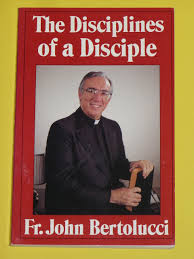How I Discovered the Real Presence.
 This past week was the feast of Corpus Christi. I look at this week, and I think to myself about the tremendous gift and power of the Eucharist.
This past week was the feast of Corpus Christi. I look at this week, and I think to myself about the tremendous gift and power of the Eucharist.
But it wasn’t always this way.
Early Beginnings
I was raised in the Episcopal Church, but it wasn’t until my high school years that I had a deeper conversion to Christ. As a matter of fact, there was a time where I had become an influential Bible study leader at my high school. It was during this time, that I had acquired many evangelistic materials that could be best construed as “anti-Catholic.”
One of the claims made in these materials was the notion that Catholics believed in (gasp!) transubstantiation. That is, that at the moment the priest raises the bread/host, and utters a prayer of consecration, the bread itself actually becomes Jesus–-body, blood, soul and divinity.
The reading materials I had collected had found this to be appalling. They repeated the notions that such was, to put it mildly, crazy at best. The only critique they offered was simply stating how incongruous they found it with their understanding of the Scriptures, and, if wrong, was tantamount to supreme idolatry.
As a young believer who found himself being drawn away from his liturgical upbringings, I found myself in agreement with the anti-Catholic rhetoric.
College
A few years later, I found myself in a different position altogether. I had joined a dynamic Christian group that appealed to me because of its association with the Charismatic Renewal. Unknown to me at the time, it happened to be filled predominantly by Catholic charismatics. I had believed Catholicism was wrong, but once I recognized that these fellow Catholics were on fire for God, I believed that Catholics can be Christians.
Nonetheless, through my interactions with them, and constant dialoguing, I came to understand why Catholics believed as they did on a whole number of issues: Mary, purgatory, confession, etc. I did not agree with them, but it was sufficient that their beliefs had made sense to some degree–and that I didn’t feel the need to disassociate with them. I can see how they honored Christ and that their beliefs drew them closer to Him. This was true even for a doctrine as contentious as transubstantiation, which, if wrong, was still honoring Christ, albeit in what-I-had-perceived-to-be a lacking manner.
Catholic Evangelization Conference
In the middle of my senior year in college, I was invited to help out with a conference directed towards Catholics about evangelization. It was to be headlined by a popular TV priest who was gifted in his oratory style. And unknownst to us, this happened around the same time that (now Saint) Pope John Paul II had issued forth a “New Evangelization.”
This conference was attended by thousands in an arena.
The preachings were great. They were insightful, entertaining, and practical. But throughout the conference they kept announcing that the conference was going to close with a “Solemn Benediction.”
“Solemn Benediction”. I had never heard of that term before. To me, it sounded like a cool experience, to join some sort of old-school ancient ritual. Should be interesting. I told my Episcopal friends that they had to come. (None did).
Finally, the moment came. The head priest came out with the monstrance with what appeared to me to be a little white bread disc inside the middle of this golden thing (which I had later known as a “monstrance”). And then, the entire arena thousands of devoted Catholics – they began kneeling in what I perceived to be a domino motion across the whole arena, from right to left.
I was surprised, frightened, and a little shaken. What is everybody doing? What do I do? At that time I didn’t believe in the Real Presence. I didn’t want to commit “idolatry,” even though I knew they were all worshiping Jesus. But at the same time, if I didn’t kneel, my head would stick out of this arena like a sore thumb. Thousands of people looking at the Host, and me. I was mortified.
Being tall, I found that I had best find some sort of compromise-position. I partially kneeled, partially squatted. I kept my head down. It was quite uncomfortable. I must’ve looked like a fool to those immediately around me. But I wasn’t going to compromise my beliefs.
And yet right then and there, it had occurred to me exactly what was at stake, in regards to my belief in the Real Presence. Either Jesus was not present, after which that what I had just witnessed was ranked idolatry of the most hideous nature, or, Jesus truly was present. And if so, then I really wanted in on this.
After this, I immediately went to the book table at the conference and purchased a volume of testimonials of Catholic converts. Some of the names had been familiar to me, and had earned my trust over the years. And as I read this volume, I began hungering for the Eucharist.
Collecting Evidence
I still had issues as to why I refrained from fully joining the church. But I knew that if the Eucharist was true, then there had to be a light at the end of the tunnel. There had to be a valid reasoning as to why the Church believed as it did. I had to trust that the reasons existed, and figure them out on my own. If I could do this, then I could complete the process of confirmation, enter into full Communion with the Church, and do so with integrity.
Over the next couple of months I had occasionally entered into churches, sat in front of the Tabernacle, and prayed that if He was really there, He would reveal Himself to me. God doesn’t answer all at once. God is content to take His time, allowing me to piece things together as I encounter more evidence.
The evidence I had gathered included:
- a new reading of John 6, where Christ reiterated the belief of transubstantiation where his disciples were scandalized, and made no apology, nor clarification that it was purely metaphorical, even with others leaving in disgust.
- a new understanding of the Passover Feast, which emphasized the importance of consuming the pure and spotless lamb, and how that translates to today.
- a discovery that, over the years, there have been something called “Eucharistic Miracles,” that science has no explanation for.
- an appreciation for the Sacraments, which I began to see as a way that God touches and ministers to our very souls, directly.
As I continued to read testimonies, gather information, and listen to talks, I also had to reconcile other Catholic doctrines with my own. Joining the Church was an all-or-nothing affair. I had to accept that if those Catholics got transubstantiation right, then there had to be logical reasons as to why other contentious-doctrines-to-me were also right. Contraception, homosexuality, and women-in-the-priesthood moved to the front burner. I wrestled with these all with new fervor.
When my last contentious issue had collapsed under the weight of the Scriptures and logic, I had no other opposition. Suddenly the Eucharist was even more inviting than ever before, beckoning me to come home. I signed up for R.C.I.A. classes. At the Easter vigil the following year, the experience of reception of Communion was, at long last, a reality. I can now receive Communion whenever I wanted to (provided I was not in the state of mortal sin, of course). I felt a closeness to Christ I had never encountered up to that point.
The key takeaway: it was Christ himself who drew me to His Church. Through the Eucharist.
The Tragic Irony of My Testimony
There is a deep, tragic irony at work here as well, and I feel that I must address this.
That priest–the one who was the main presenter of that Evangelization Conference, who had delivered three of its keynotes, and had led the procession during the Solemn Benediction, he was none other than Fr. John Bertolucci.

Fr. John Bertolucci
In 1992, Fr. Bertolucci was one of the most foremost of celebrity priests. He had written five books, was a frequent guest on EWTN, and was a highly in-demand public speaker. He was an inspiration, second to none. It turns out that this priest had specific skeletons in his closet, the scandalous sort that would make headlines just ten years later. In 2002, once the Church began implementing its “no tolerance” policy towards convicted pedophile priests, his priestly faculties were swiftly removed.
How my heart aches for these victims.
Does Fr. John Bertolucci’s heinous actions lose any validity for my experience of receiving/believing the doctrine of the Real Presence? No doubt it probably has led to some individuals’ loss of faith.
And yet, here I am. Partially because of that day.
That moment had left me with a choice to either pursue the answers for clarity, or to throw it all away. It would be very easy to chalk all of it up to some group-dynamics and peer pressure; but had I not persevered in understanding the logical basis of the belief, I would have fallen away, years later, when I found myself alone in this belief.
Jesus had begun the process to show Himself to me in that moment, despite the very tragic/heinous sins of that priest. Jesus does not limit himself the power of showing grace to his own, just because of the grave failings of those who have been entrusted with priestly faculties.
Not to downplay those acts (and don’t dare think I am doing such), but… had Jesus waited until all of our failings had been corrected and cleaned to then use us for His glory, then the world would be waiting a long time. We would never be introduced to what the Gospel is.
God was gracious to use a severely broken and interiorly corrupted vessel to light a fire in my heart, to get to the bottom of the question as to whether Christ is truly present in the Eucharist. He could have used anybody. It could have happened at any other time. Or, he could have been content with my then-ignorance and allowed me to continue to worship Him, outside of this knowledge. But He didn’t, and my life had changed as a result.
Let Christ be Christ
I reminisce about this story and conclude that grace is best displayed when we let Christ be Christ.
When parishes introduce perpetual adoration to its congregants, they are letting Christ be Christ to them. Politics fade. Dissents dissipate. Humanity’s failings are obscured. The only concern one would have is the question as to whether Christ truly is present, right then, right there, in a unique manner. And whether such beliefs could be held in our technologically-rich, scientifically-dominated society.
And if this truly is Christ, then the next step is obvious: what then should be our response? How shall we put our faith in action?
Would we not want to do everything in our power to be set a fire for him, and him alone? Should we not want to strive for holiness? Should we not understand why the church believes as it does? Should if we are prohibited from reception of the Eucharist should we not pursue every possible avenue to bring about reconciliation with Christ?
And if we do believe that beacon of light for others, should we not make the introduction of this counter-cultural belief of the Real Presence, near the very top of our priorities?
Our testimony may be weak. Our grasp for apologetics may be lacking. Our sins may be in full view of everyone who knows us. Maybe we could work hard to overcome these roadblocks. And we should. We most absolutely should.
But perhaps we should also, more importantly, step out of the way and let Christ be Christ.
Postscript: it has come to my attention that John Bertolucci had passed away, some two weeks prior, on May 26, 2015. His obituary made no mention of either his illustrious history and scandal–ridden past. May God have mercy on his soul, and may his victims find full healing in His grace.









Wow Nick! I had no idea you were so insightful and inspiring, and not only that, you’re an excellent writer. You should write a book!
Thank you so much! Great to hear from you. Hope all is well.